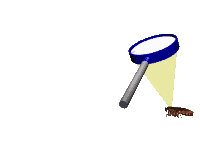
 |
Silverfish, |
DESCRIPTION
MEET THE PEST
The feeding habits of silverfish cause problems for homeowners. This ancient pest feeds on products which are starchy, sweet and high in protein. Included in this list are glued paper (book bindings), cereal, clothing, gum, paste and wallpaper. The silverfish is a wingless insect with long antennae, three slender appendages coming from its abdomen and three pairs of legs. It is approximately 0.5 inch (1 1/4 cm) long, has a flat, silver scaly body which is thicker near the front section and tapers in towards the bottom (carrot shaped).
Silverfish prefer dark, damp, warm places such as bathrooms, kitchens and furnace rooms. They are most active at night (they hide during the day). Popular hiding locations include bookcases, windows, door frames and in closets. Silverfish are active year-round; thus damage can occur at any time, provided conditions are suitable. Damage caused by silverfish feeding include uneven holes in paper, books and flooring. They sometimes leave a noticeable yellow stain on material such as linen.
LIFE CYCLE
The life cycle of the silverfish include egg, nymph and adult stages. Hundreds of eggs are laid in cracks by the female silverfish. Over a period of a few weeks, several batches of eggs are laid. Each batch consists of a small number of white, oval eggs. They usually hatch in one month if warm temperatures are present. Once the eggs hatch, nymphs (a smaller version of the adult) emerge. The nymphs increase in size until they become adults three months later. Adult silverfish usually live two to three years.
CONTROL - Monitor
Monitoring for silverfish is the first step in control. It is important to determine if the damage is indeed caused by this insect. A simple mixture can provide this information for you. Make a paste by mixing flour and water (keep it fairly thick), spread it on cardboard and let it dry. Place the cardboard in an area where silverfish are suspected. It is easy to determine if feeding has taken place (bite marks and scraped surfaces). A glue board may also be used to trap silverfish.
Physical
If silverfish are present, change the environment where they are located. Physical control can be easily achieved by cleaning, vacuuming, steam cleaning, altering the temperature to make the room hotter or colder, dehumidifying and trapping.
Other options to achieve control include caulking openings around pipes and wires to prevent passage from room to room, storing books and paper products in dry areas to avoid dampness, or, if the room is too damp, heating the area.
A trap can be made by placing masking tape around the outside of a small glass bottle, and laying a piece of bread inside for bait. Lay the trap in an area where silverfish have been seen. The silverfish will climb in to get the food, but will be unable to get out because they cannot climb on smooth surfaces. Once captured, drop the silverfish in a bucket of soapy water. Infested items such as clothing and books can also be placed in the freezer. Freezing will kill all life stages.
Chemical
If physical control measures are not effective, use a pesticide which will have a minimal impact on both you and the environment. Use diatomaceous earth or silica aerogel. These are insecticides which act as abrasives. They cut the outer layer of the silverfish's body causing it to dehydrate and then die. Boric acid can also be used to control silverfish. Spray or dust baseboards, doors, window casings, closets, cracks, bookshelves and openings according to label instructions.
If the above measures are not effective, consult with an expert.
| Phone 3861-5857 | Mobile 0403-949098
|
| Licence No. | PMT-O-10363 |  |
|
| Q.B.S.A No. | 1066314 | ||
| S.I.C. No | 0247341 |